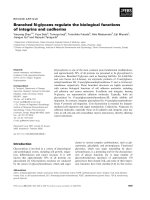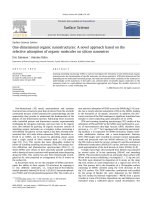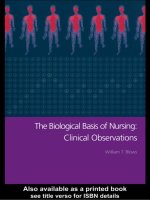- Trang chủ >>
- Khoa Học Tự Nhiên >>
- Vật lý
a means to an end the biological basis of aging and death apr 1999
Bạn đang xem bản rút gọn của tài liệu. Xem và tải ngay bản đầy đủ của tài liệu tại đây (3.05 MB, 246 trang )
A Means to an End
WORKS BY WILLIAM R. CLARK
The Experimental Foundations of Modern Immunology
At War Within: The Double-Edged Sword of Immunity
Sex and the Origins of Death
The New Healers: The Promise and Problems of Molecular
Medicine in the Twenty-First Century
A Means to an End
The Biological Basis of
Aging and Death
William R. Clark
New York Oxford
OXFORD UNIVERSITY PRESS
2002
Oxford University Press
Oxford New York
Athens Auckland Bangkok Bogota Buenos Aires
Calcutta Cape Town Chennai Dar es Salaam
Delhi Florence Hong Kong Istanbul Karachi
Kuala Lumpur Madrid Melbourne Mexico City
Mumbai Nairobi Paris Sao Paulo Singapore
Taipei Tokyo Toronto Warsaw
and associated companies in
Berlin Ibadan
Copyright © 1999 by Oxford University Press
Published by Oxford University Press, Inc.
198 Madison Avenue, New York, New York 10016
First issued as an Oxford University Press paperback, 2002
Oxford is a registered trademark of Oxford University Press
All rights reserved. No part of this publication may be reproduced,
stored in a retrieval system, or transmitted, in any form or by any means,
electronic, mechanical, photocopying, recording, or otherwise,
without the prior permission of Oxford University Press.
Library of Congress Cataloging-in-Publication Data
Clark, William R., 1938-
A means to an end : the biological basis of aging and death /
by William R. Clark.
p. cm. Includes bibliographical references and index.
ISBN 0-19-512593-2 0-19-515375-8 (pbk)
1. Cells—Aging. 2. Apoptosis. I. Title.
QH608.C53 1999
612.67—dc21 98-18878
135798642
Printed in the United States of America
on acid-free paper
For Erica
TMD
Contents
Acknowledgments, ix
Introduction, xiii
1. Aging, Senescence, and Lifespan, 3
2. The Nature of Cellular Senescence and Death, 21
3. The Evolution of Senescence and Death, 41
4. Of Embryos and Worms and Very Old
Men: The Developmental Genetics of
Senescence and Lifespan, 59
5. Human Genetic Diseases That Mimic
the Aging Process, 73
6. Cycling to Senescence, 95
7. Replicative Immortality: Cancer and Aging, 115
8. Caloric Restriction and Maximum Lifespan, 131
9. With Every Breath We Take: Oxidative Stress
and Cellular Senescence, 149
10. The Aging Brain, 169
11. A Conditional Benefit, 189
Bibliography, 221
Acknowledgments
As always, a number of people have contributed to the mak-
ing of this book. Kirk Jensen at Oxford University Press urged me to
write on this topic in the first place, and has provided valuable guid-
ance throughout. I have profited greatly from advice and inspiration
from several colleagues: James Carey, Rita Effros, Edie Gralla, Caleb
Finch, David Kirk, David Reznick, and Joan Valentine, among others.
The length of human life, according to the Greeks, was in the hands
of the Fates, or Moerae. These three sisters, daughters of the Goddess of
the Night, measured out the beginning, the middle, and the end of each
life. Klothos spun the threads from which destinies could be woven, in-
corporating fibers of good or evil, happiness or tragedy into each thread.
Lachesis apportioned these threads to each individual at the hour of
birth, determining their length, which determined the length of each
life. The third sister, Atropos—she who could not be turned aside—
guarded the dread scissors that were used to cut each thread, defining
the moment of death.
It is said that the three sisters were present at the birth of the great
hero Meleagros, son of Oineus. Klothos spun the noblest of threads for
his lifeline. Lachesis selected among these to assure his status as a hero
among men. But Atropos measured her scissors along this line, and pre-
dicted he would live only as long as the log that was on the fire at his
birth. At this pronouncement Meleagros' mother, Althaea, snatched the
log from the flames. Years later, in a fit of anger, she threw the log back
on the fire. The scissors descended, and cut the beautiful thread, so lov-
ingly woven into a life. . . .
Introduction
The awareness that we are growing old may be uniquely
human. Perhaps other animals, particularly some of the higher mam-
mals with rudimentary cognitive function, may be aware that they are
slowing down in many ways, unable to keep up with others in their
group, less able to find food or capture prey, slower to move away from
danger or a predator. But we doubt they understand the full implica-
tions of the process. Humans do. Only we wonder how Lachesis mea-
sures out her thread; only we want to know the nature of Atropos's
scisssors. Alone among the animal species that inhabit this planet, we
are endowed with consciousness, an awareness of self—where we came
from, and where we are going. We alone know, only too well, that the
endpoint of aging is death. This drives a concern in us about the inner
workings of the aging process—senescence—that is completely lack-
ing in other species.
For some, old age is a time of peace and joy, of reflection on life's
bountifulness, a time to contemplate the only immortality we can
know: the lives of our children and grandchildren. With luck and a lit-
tle attention to diet and exercise, we can maintain our ability to engage
both physically and mentally in those lives, and in our community of
friends. But it is not so for all of us. Genetics, accident, the "luck of the
draw"—all of this can play against us in our later years, depriving us of
the ability to participate fully and meaningfully in the world around
us. All of us have this fear as we sense old age approaching, for it can
happen to anyone. And at some level, even in the lucky ones, this fear
never really goes away, because we know from observing other lives
that at any moment our fate could change.
INTRODUCTION
So it is in a sense fear that drives us to study aging, to try to under-
stand it; to name its parts, to unravel how they work and how it all fits
together. Organized attempts to study aging in a systematic way were
slow in getting started: The first professional societies dedicated to
promoting basic research in senescence and aging (gerontology) and a
medical specialty dealing with the problems of the aged (geriatrics)
were not formed until the 1940s. As with any new field, the early years
of the study of aging were filled with confusion and uncertainty. The
aging process seems enormously complicated, involving complex
changes in virtually every different cell type in the body. Graying hair,
failing eyesight, declining physical ability and mental capacity—each
of these seems like a separate physiological process, each with its own
biochemical and genetic regulation.
The study of aging has some intriguing similarities to the study of
cancer, and these may be instructive. For most of its clinical history,
cancer was viewed as a thousand or more different diseases, at least as
many different cancers as there were different cell types in the body,
each requiring different treatment, each with its own outcome. But
today our view of cancer is radically different. What we see now are the
incredible similarities of cancer. Nearly all cancers involve mutations
in a limited number of genes distributed throughout all cells in the
body. This knowledge has provided a completely new basis for design-
ing new strategies for both the detection and the treatment of cancer,
strategies that are already finding their way to the clinic. The lesson
from cancer that we can apply to aging is the need to understand phys-
iological processes at their most fundamental level, at the level of the
very genes that regulate it. Complex organisms like humans are com-
posed of individual cells, and that is where the aging process begins.
The aging of any organism is a reflection of the cumulative senescence
of its component cells. The enormous variety of cell types in the
human body, each with its own peculiar aging characteristics, or aging
"phenotype," might seem to confound the search for common cellular
aging mechanisms. But just as complexity in cancer came to be viewed
as derangements in a limited number of genes operating in all cells, so
too may senescence.
These new views of cancer and aging are part of the new field of
human medicine called molecular medicine, which is in turn the fruit
of basic research throughout this century in biochemistry, genetics, and
XIV
INTRODUCTION
molecular biology. Completion of the Human Genome Project early
in the next century will eventually make it possible to identify each of
the key genes involved in human aging. We will then be able to dissect
senescence and aging at a level never before possible. In the past, we
have had to approach aging much as the proverbial blind men ap-
proach elephants, describing it from without, in fragmented terms, try-
ing to guess the meaning and origin of each component, with only the
dimmest of views of the larger picture.
But that is about to change; soon we will see the thread of our
lives—once thought to be spun, woven, and cut by fate—from a new
perspective, from the inside of our own DNA. The guesswork will be
gone; the view will be spectacular. What will we do with this informa-
tion? How will we use it? All of us need to be engaged in a discussion
of this and every other aspect of molecular medicine as we enter the
next century, the next millennium. Aging is a wonderful place to start.
In this book we will take a close look at what molecular medicine and
its underlying sciences have to tell us about this most mysterious and
fascinating of human biological processes.
xv
A Means to an End









